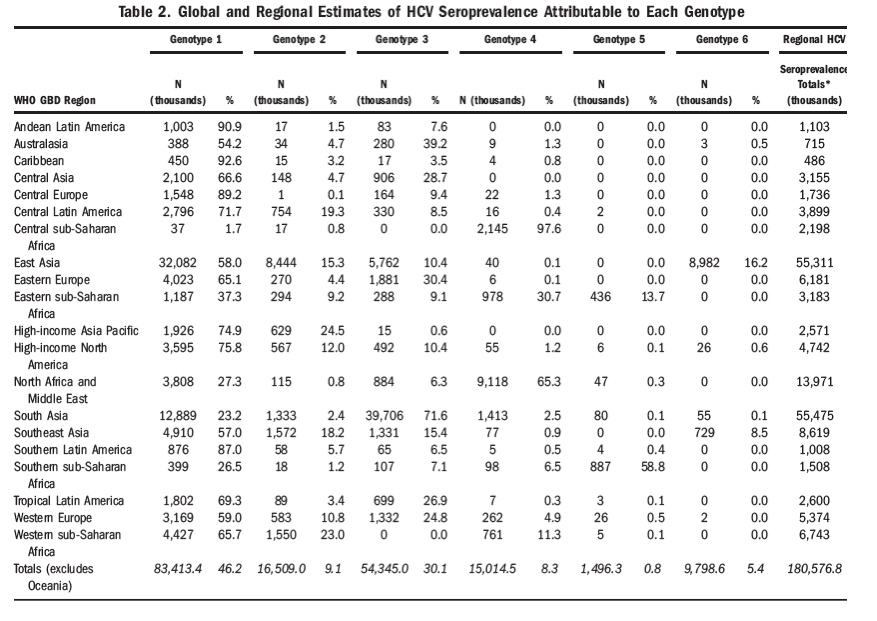| |
Global Distribution & Prevalence of HCV Genotypes (GT3)
|
| |
| |
http://www.natap.org/2014/HCV/073014_03.htm
Globally, genotype 1 is estimated to account for more HCV cases than any other genotype at 83.4 million (46.2%), with over one-third of genotype 1 cases located in East Asia.
HCV genotype 3 is the next most common and is estimated to account for 54.3 million (30.1%) cases globally, approximately three-quarters of which occur in south Asia. Genotypes 2, 4, and 6 are responsible for the majority of the remaining cases of HCV worldwide, with an estimated 16.5 million (9.1%), 15.0 million (8.3%), and 9.8 million (5.4%) cases, respectively. East Asia accounts for the greatest numbers of genotype 2 and genotype 6 HCV cases, while North Africa and the Middle East have the largest number of genotype 4 cases. We estimate genotype 5 to be responsible for the fewest HCV cases globally (1.4 million, <1% of all HCV cases), the great majority of which occur in Southern and Eastern sub-Saharan Africa.
Figure 2A displays the most common genotype by country. Genotype 1 is the most common genotype in 85 of the 117 countries identified as having genotype information in our study, and is highly prevalent worldwide. Of the 53% of genotype 1 cases for which the subtype was specified, we find 99% to be attributable to subtypes 1a and 1b (31% and 68%, respectively). A map showing the dominance of subtype 1a versus 1b in countries whose relative prevalence of genotype 1 exceeds 25% is provided in the Supporting Information (Fig. S5). We observed that genotype 2 dominated in West Africa, genotype 3 in south Asia and parts of Scandinavia, genotype 4 in Central and North Africa, Genotype 5 in South Africa, and genotype 6 in SE Asia.

------------------------
J Hepatol. 1997 Mar;26(3):484-91.
Distribution of hepatitis C virus genotypes in German patients with chronic hepatitis C: correlation with clinical and virological parameters.
Berg T1, Hopf U, Stark K, Baumgarten R, Lobeck H, Schreier E.
Author information
Abstract
BACKGROUND/AIMS:
The hepatitis C virus genotypes have been shown to be differently distributed between distinct geographical areas and to be associated with different clinical presentations. In the present study we investigated the distribution of HCV genotypes in 379 German patients with chronic hepatitis C in relation to age, sex, route of infection, liver histology and viremia.
METHODS:
Typing of HCV was done using restriction fragment length polymorphism analysis as well as a DNA enzyme immunoassay. HCV RNA concentrations were determined by quantitative polymerase chain reaction. Liver biopsies were performed in 187 patients and the histological activity was graded by the Knodell score.
RESULTS:
Seventy percent were infected with genotype 1 (20% subtype 1a, 80% subtype 1b), 4% with genotype 2 and 26% with genotype 3 (all subtype 3a). Genotype 3a and 1a infection was significantly associated with intravenous drug abuse. In contrast, genotype 1 predominated in patients with post-transfusion hepatitis and infection of unknown origin. A changing relative prevalence of HCV genotypes in relation to age was also observed. Patients with genotype 3 infection showed significantly lower HCV RNA levels and a lower mean histological activity score as compared to patients with genotype 1 and genotype 2. However, using multivariate analysis, only age and mode of transmission but not histological activitiy score were shown to be independent variables.
CONCLUSIONS:
Our study confirms previous reports from other countries that HCV variants can be classified into a relatively small number of discrete genotypes, and that the subtype 1b clearly predominates. However, we found evidence that there is a changing relative prevalence of HCV genotypes in relation to age, and that the mode of transmission is reflected in the predominance of certain genotypes.
----------------------------
http://www.eurosurveillance.org/ViewArticle.aspx?ArticleId=19492
Eurosurveillance, Volume 15, Issue 8, 25 February 2010
Research articles
Chronic hepatitis C in Austria, 1992-2006: genotype distribution and demographic factors
A Maieron1,2, S Metz-Gercek3,2, F Hackl4, C Luger3, A Ziachehabi1, R Strauss5, R Schofl1, H Mittermayer3
1. Internal Medicine IV, Department of Gastroenterology and Hepatology, Elisabethinen Hospital Linz, Linz, Austria
2. These authors contributed equally to this manuscript
3. Department of Hygiene, Microbiology and Tropical Medicine, Elisabethinen Hospital Linz, Linz, Austria
4. Department of Gastroenterology and Endoscopy/Hepatology, Diakonissen Hospital Linz, Linz, Austria
5. Federal Ministry of Health, Family and Youth, Vienna, Austria
In a report from Slovenia from 1997, genotype 3 accounted for approximately 20% of cases [27] and in Italy in 2003, genotype 3 was found in about 12% of chronic hepatitis C patients [28].
Chronic hepatitis C is a leading cause of end-stage liver disease and, with a worldwide prevalence of up to 3%, is a pandemic infectious disease. Austria, like most western European countries can be considered as a low prevalence country. This analysis aimed to assess the distribution of hepatitis C virus (HCV) genotypes in patients with chronic HCV infection in Upper Austria. Between September 1992 and December 2006, we identified 1,318 consecutive patients who tested positive for HCV RNA. Genotyping was routinely performed in 1,239 of the 1,318 patients, and in a subgroup of 617 patients data on the source of transmission were collected. Additionally we obtained data on liver histology and body mass index in a subsample of 273 of the 617 patients. Hepatitis C genotypes 1, 2, 3, 4, 6 and co-infections were found in 80.4%, 4.5%, 12.3%, 2.7%, 0.1% and 0.2% of the patients, respectively. There was a highly significant age difference in relation to gender at the time of diagnosis of chronic hepatitis C, with women being older than men (men: 45.0 years; women: 49.3 years; p<0.0001). The number of new cases of chronic hepatitis C decreased substantially over the last decade, but although risk factors for obtaining HCV are well established, we did not find a decrease in the age of first diagnosis. Besides consistent screening in defined risk groups it is important to raise awareness for risk factors for HCV acquisition and liver disease progression.
|
|
| |
| |
|
|
|